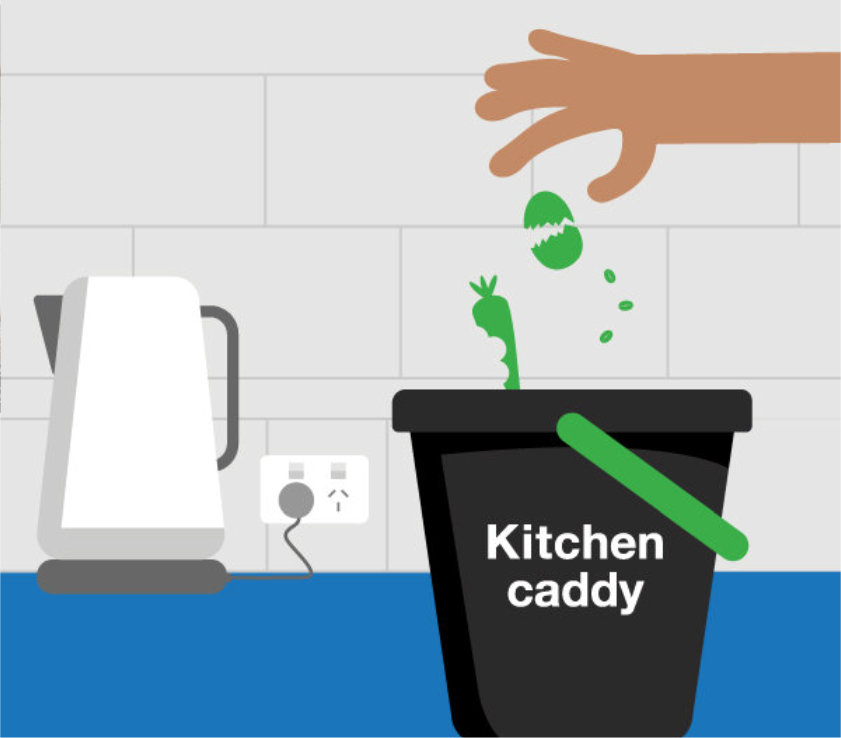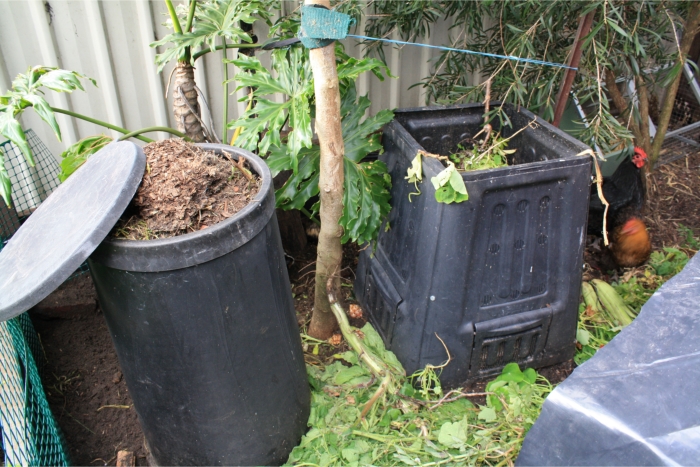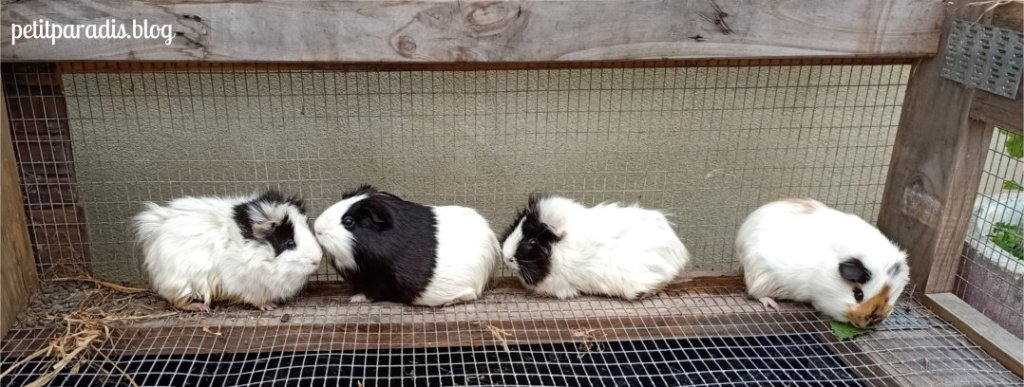In our previous post on the introduction of the FOGO service to our city last year and the mission for the service to reduce landfill waste whilst creating community generated compost. For Mrs PP, this practice of utilising kitchen scraps has always been a way of life for us (since we married) and we’ve used it to increase our soils in order to ultimately increase food production. I’ve been around long enough to know that most people will use the FOGO system and divert their food and green waste to the FOGO bin where it will be taken for commercial composting. This is a simple system and in being inherently simple, I think it will be utilised.

For those backyard gardeners who do have the extra care and inclination to increase their productivity in the garden, I have something to share.
Most municipalities around the world now have their waste being directed to specific places. Not just collected and buried in a pocket within suburbia like back in the day when it was out of sight, out of mind. This is a good thing, and I hope that in time more and more specific uses evolve for putting this recycled waste back into the system in more effective and useful ways. **
For the home gardener, using kitchen scraps is almost a given. It’s just something that a lot of backyard gardeners and chicken owners have done. For someone that practices permaculture however, it can be a very conscious and deliberate act of design. Taking something like waste and milking it for all it’s worth.
So what might this look like for a suburban household?
Well, it’s all about getting the most bang for your buck as far as nutrition and energy. Food waste from the kitchen could go to the worm farm which then produces vermi-compost (decomposed organic matter and worm castings) and liquid fertiliser for the garden. Eventually the vermi-compost gets harvested and used in the garden as a soil amendment.
We can extend this process by adding in more elements to increase the benefits and products. We might have the capacity to put our food waste into a compost bin situated within a chicken yard. Once full and starting to decompose we can remove the bin and allow the chickens to scratch through the debris and feed on insect life. They in turn shift and mix the materials which can then be raked and placed into another compost bin for a further time to break down. You might get a couple of feeding sessions from this method before possibly finishing the composting process through another compost bin or putting it into a worm farm.

We’ve used this method very successfully in the past. Especially with the addition of further kitchen scraps that we might put aside for the chickens to feed on, and also continually adding shredded paper or ripped up strips of newsprint. For us, here in a temperate climate where we don’t experience snow, it is a particularly fantastic method to use during our winters. The rainfall keeps the paper and newsprint damp and the chickens are continually scratching and aerating the whole mix. Put through a sieve, it produces a crumbly, dark brown soil that is fantastic for growing container plants. Extra enriched with chicken manure too, but enough so as to damage plants through manure burn.
The chickens received extra protein through the compost bins insect and worm life. They will keep exterior insect pests to a minimum and deter mice. You get eggs and you don’t need to mix the compost materials as this is done whilst the chickens scratch and aerate the materials during feeding. All the while they are adding manure to the mix which will benefit the composting process when you fill the next bin or the worm farm. The worm farm can also contribute worms for feeding to the chickens or other animals in the garden such as fish.
For someone that practices permaculture however, it can be a very conscious and deliberate act of design. Taking something like waste and milking it for all it’s worth.
At the end of it all, you still get valuable soil to enhance your garden with and you’ve still raised worms. Added to this though, you’ve also hopefully gained some eggs, some extra fertilised and matured compost and possibly even some extra worms to spread out into your broader garden area.
The game is to find ways that you can make the same waste product go further while increasing the benefits with multiple spin-offs that will enhance your garden, your environment and your health.
When you add in extra elements as your permaculture system expands, the potential to extend the usefulness of your household and garden waste also increases. You can also begin to refine the process as you determine what the specific needs are for each element.

One last example for you. When we had rabbits, they seemed a little more particular about what they ate and the quantities they ate. They were quite finicky. They could eat a vast amount of food but not a great variety. Guinea Pigs on the other hand were less fussy and would eat a much broader variety of plants and still managed to chomp through a decent quantity of food. Keep in mind that some of this was in the form of weeds and grasses from the garden.
Rabbit and guinea pig manure is pretty decent stuff for the garden. Put through a worm farm it takes on magical qualities and the worms have a field day. So imagine a bulk load of kitchen scraps such as cabbage leaves, corn husks, cauliflower stalks, fruit trimmings, carrot tops and peelings. This could potentially go into a worm farm and create vermi-compost after some time. If you introduce rabbits and guinea pigs into the equation they will munch their way through this bulk waste in no time and create manure that can be used in the garden, compost or worm farm. In fact, any left-overs from cleaning out the animal pens is best put through the compost bins or worm farms. So even the animal waste enters the system and introduces a nutrition source.
With a little thought, you can find a process that is going to suit your requirements and also accommodate the uniqueness of how you garden. Think the process through. Start small and build on it as you see new possibilities. Refine it. Make it easy and reap the benefits that a growing diversity can bring to your backyard gardening.
Further Information:
For Albany locals : information on the FOGO bin service
Previous Post on the FOGO service
** I am very interested to know if any readers have a system like this provided for them and where you would be in the world.
Do you have a FOGO service or similar?
Or do you, like us, recycle/compost your kitchen scraps?
Do you have other processes that you use that might be quite unique to your situation?
Yes and no. Within the urban areas that I am familiar with, primarily in the Santa Clara Valley, there is nothing like the FOGO system, and if there were, I doubt that it would be practical for such a ridiculously apathetic populace. Most or all municipalities have recycle bins (one for paper and cardboard, and another for cans and bottles and such) but most of those bins do not get used. (As I mentioned earlier, those at the apartment building I lived in filled with trash if they happened to be closer to the gate than the trash bin was.) Only greenwaste gets recycled in some communities, and only because it would be too expensive to dispose of like trash. Some municipalities or neighborhoods have large greenwaste bins. Others pick up small piles of greenwaste that get put out to the curb. My neighborhood in town did not recycle greenwaste. However, in San Jose, greenwaste gets picked up weekly if it just gets put out to the curb in 3′ X 3′ X 3′ piles. Kitchen waste is not allowed. In fact, debris from the garden can not include fruit, or pieces of yucca or palm. I recycle just about everything back into the garden, or a large compost pile at work. Even palm and yucca, which get piled separately, decomposes. . . . However, in the old neighborhood, there was a neighbor who had a view of my garden, and actually complained if she saw anything that she thought would attract vermin. Kitchen scraps were NOT allowed. Actually, she disapproved of the garden altogether because squirrels enjoyed it so much. There is nothing unique about the garden, except that the processes are relatively primitive, as I learned them. I have no use for fancy contraptions that are supposed to help, but really just add more plastic to the environment (such as plastic compost bins). What we do at work is unique, only because we generate SO much greenwaste. We are in a dense forest of some of the tallest trees in the World. We remove tons of debris that we can not recycle. Some gets tossed back out into the forests surrounding the landscaped areas, but we do not like to accumulate too much combustible material. Much of the debris therefore comes back to a yard to be chipped. We generate more chips than we can use, so neighbors take what they want.
LikeLike
That is an amazing and eye-opening view into another western community that is so highly contrasted to what I thought it would be. There are so many points to comment on Tony. I shall return to do so!
Thank you.
LikeLiked by 1 person
That is it exactly. It is not how we portray ourselves. People believe that we are innately so environmentally responsible while we are not. Meanwhile, we blame toxins in the rivers on the homeless Community, who really do not have much to produce so much toxins. If we were really concerned about the homeless, and did not need them to take our blame, we would get them into homes where they would not ’cause’ so many ‘problems’. This is the wealthiest Community in America, but we can not take care of our homeless.
LikeLike